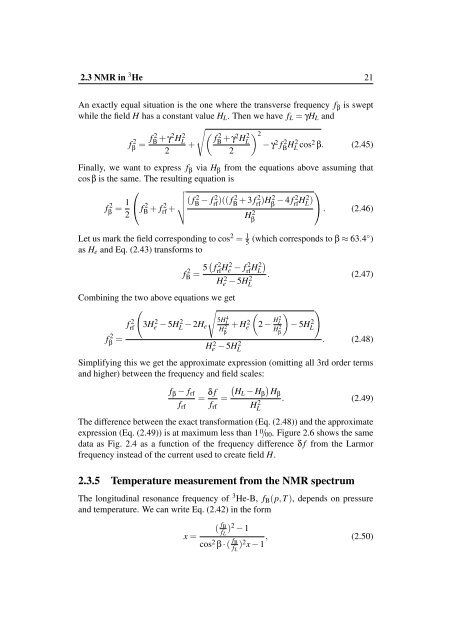NMR Techniques at Liquid Helium Temperatures - Low ...
NMR Techniques at Liquid Helium Temperatures - Low ...
NMR Techniques at Liquid Helium Temperatures - Low ...
Create successful ePaper yourself
Turn your PDF publications into a flip-book with our unique Google optimized e-Paper software.
2.3 <strong>NMR</strong> in 3 He 21<br />
An exactly equal situ<strong>at</strong>ion is the one where the transverse frequency fβ is swept<br />
while the field H has a constant value HL. Then we have fL = γHL and<br />
f 2 β = f 2 B + γ2H2 <br />
<br />
L f 2<br />
B + γ<br />
+<br />
2<br />
2H2 L<br />
2<br />
2<br />
− γ 2 f 2 B H2 L cos2 β. (2.45)<br />
Finally, we want to express f β via H β from the equ<strong>at</strong>ions above assuming th<strong>at</strong><br />
cosβ is the same. The resulting equ<strong>at</strong>ion is<br />
f 2 ⎛<br />
1<br />
β = ⎝ f<br />
2<br />
2 B + f 2 rf +<br />
<br />
<br />
<br />
( f 2 B − f 2 rf )(( f 2 B + 3 f 2 rf )H2 β − 4 f 2 rf H2 L )<br />
H 2 β<br />
⎞<br />
⎠. (2.46)<br />
Let us mark the field corresponding to cos2 = 1 5 (which corresponds to β ≈ 63.4◦ )<br />
as He and Eq. (2.43) transforms to<br />
f 2 B = 5 f 2 rfH2 e − f 2 rfH2 <br />
L<br />
. (2.47)<br />
H 2 e − 5H 2 L<br />
Combining the two above equ<strong>at</strong>ions we get<br />
<br />
<br />
f 2 β =<br />
f 2 rf<br />
3H 2 e − 5H 2 L<br />
− 2He<br />
5H 4 L<br />
H 2 β<br />
+ H 2 e<br />
H 2 e − 5H 2 L<br />
<br />
2 − H2 L<br />
H2 <br />
β<br />
− 5H2 <br />
L<br />
. (2.48)<br />
Simplifying this we get the approxim<strong>at</strong>e expression (omitting all 3rd order terms<br />
and higher) between the frequency and field scales:<br />
fβ − frf<br />
= δ f<br />
<br />
HL − Hβ Hβ<br />
=<br />
. (2.49)<br />
frf<br />
frf<br />
The difference between the exact transform<strong>at</strong>ion (Eq. (2.48)) and the approxim<strong>at</strong>e<br />
expression (Eq. (2.49)) is <strong>at</strong> maximum less than 1 0/00. Figure 2.6 shows the same<br />
d<strong>at</strong>a as Fig. 2.4 as a function of the frequency difference δ f from the Larmor<br />
frequency instead of the current used to cre<strong>at</strong>e field H.<br />
2.3.5 Temper<strong>at</strong>ure measurement from the <strong>NMR</strong> spectrum<br />
The longitudinal resonance frequency of 3 He-B, fB(p,T ), depends on pressure<br />
and temper<strong>at</strong>ure. We can write Eq. (2.42) in the form<br />
x =<br />
( fB<br />
fL )2 − 1<br />
H 2 L<br />
cos 2 β · ( fB<br />
fL )2 x − 1<br />
, (2.50)

















